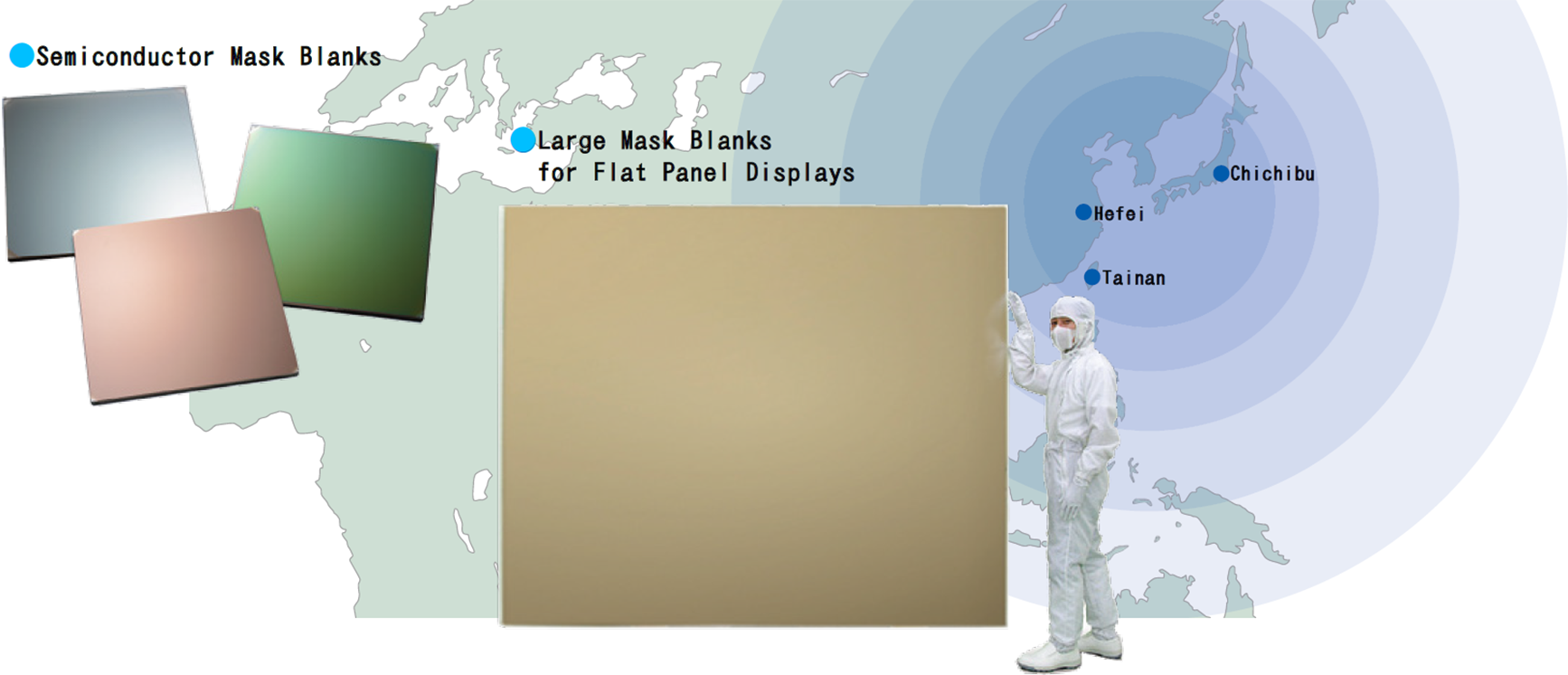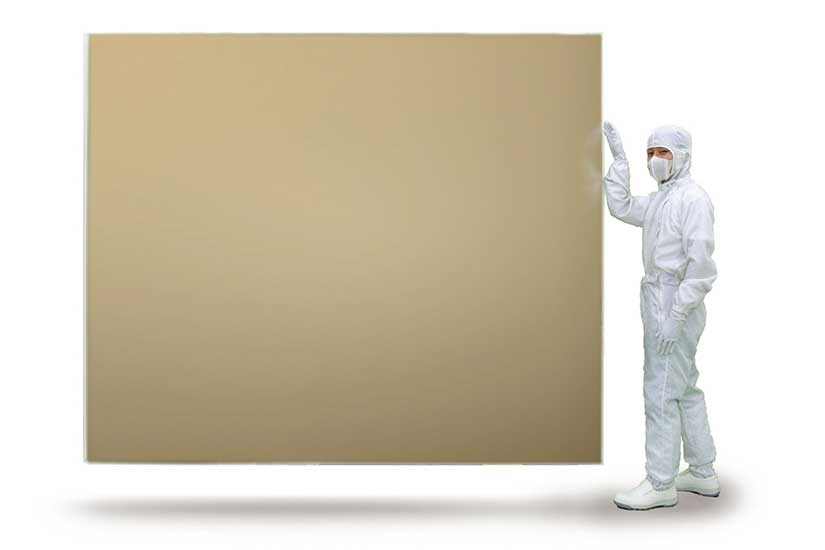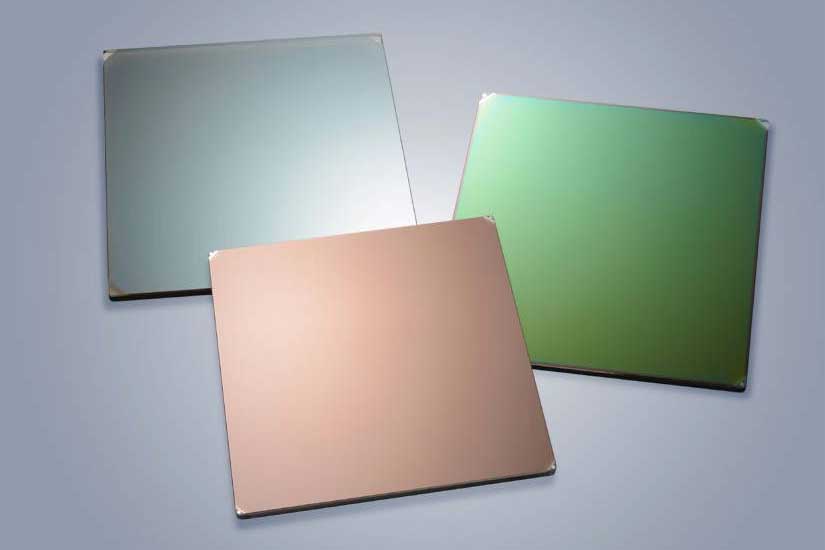Features of ULVAC Coating Corporation (ULCOAT) Mask Blanks
- 1By applying inline-type sputtering deposition equipment to the binary chrome film products, we are able to maintain the optical characteristics and quality stability while achieving excellent mass production capabilities.
- 2We have introduced various advanced deposition and cleaning equipment to ensure a low defect rate.
- 3We are addressing various types of film materials and advancing product supply, improvements, and new developments tailored to customer needs (HTM/PSM/others).
At ULVAC Coating Corporation, we have produced numerous mask blanks and have consistently worked on improving the quality of existing products.
We have secured the capacity to meet the increasing demand for mask blanks and have established a system to consistently produce products that meet the quality requirements of our customers.
Semiconductor Mask Blanks Business
Semiconductor Mask Blanks Production Process
Semiconductor Mask Blanks Manufacturing Process
Semiconductor Department Process Flow
Incoming
Quartz glass substrates
1 arrow_forwardPolishing
2 arrow_forwardCleaning
3 arrow_forwardInspection
4 arrow_forwardDeposition
Cr, MoSi
5 arrow_forwardCleaning
6 arrow_forwardInspection
7 arrow_forwardCoating
Resist
(photosensitive material)
8
arrow_forward
Inspection
9 arrow_forwardShipment
10FPD Mask Blanks Business
FPD Mask Blanks Production Process
FPD Mask Blanks Manufacturing Process
FPD Department Process Flow
Incoming
Large size glass substrates
1 arrow_forwardPolishing
2 arrow_forwardInspection
3 arrow_forwardDeposition
Cr, MoSi
Other
4
arrow_forward
Cleaning
5 arrow_forwardInsepction
6 arrow_forwardCoating
Resist
(photosensitive material)
7
arrow_forward
Inspection
8 arrow_forwardShipment
9Development Story
The roots of our mask blanks lie in material development utilizing our in-house vacuum equipment.
ULVAC was conducting material development using in-house-developed vacuum equipment in the late 1960s. This initiative was encouraged and directed by Chikara Hayashi, the vice president at the time.
The result was a hybrid thin film of chrome cermet (a type of composite metal material containing chrome oxide), which was applied to sunglasses to block direct sunlight. However, as there was no clear idea of how to utilize its properties beyond sunglasses, it was never commercialized and was left abandoned in a corner of the exhibition room.
One day, a manager from a major electronics manufacturer saw the sunglasses and remarked, "Since the chrome film blocks ultraviolet rays, it might be useful as a mask for IC circuits." This single comment sparked the person in charge's curiosity and investigative spirit.
Without delay, our engineers investigated the status of IC circuit masks and discovered that the emulsion method using photographic plates was being utilized.
Development of the world's first mask blanks, expanding into the global market
The advancement of semiconductor integrated circuits (ICs) cannot be discussed without mentioning the miniaturization of circuit patterns enabled by photolithography technology. At the core of photolithography technology is photomask technology. Furthermore, the base material for a photomask is called a mask blank. As the word 'blank' suggests, a mask blank refers to the original plate before the circuit pattern is created. These mask blanks are currently used not only for semiconductor ICs but also for FPDs (Flat Panel Displays). Mask blanks can be broadly classified into two types based on their materials: hard masks and emulsion masks. However, at that time, hard masks had not yet been put into practical use, and emulsion masks were the mainstream. Emulsion masks were made by coating a substrate, such as glass, with a silver halide emulsion, similar to that used in photographic plates. The drawback of this type was that the coated surface was not transparent, making it unsuitable for alignment when stacking multiple layers. As the trend toward higher integration continued at the time, there was an increasing demand for mask blanks that allowed for more precise work.
The conclusion ULVAC reached was: "Since the light source used in IC manufacturing processes is ultraviolet, allowing visible light (can be detectabl by the human eyes) to pass through poses no issue. In other words, if we could create a film that transmits visible light but blocks only ultraviolet light, it would enable alignment tasks to be performed while visually verifying positioning. By using the chrome film we developed, we have created an innovative solution that fully overcomes this drawback.
This led to the completion of the chrome film hard mask blank in 1970. Initially named the 'ST Mask', it was also the world's first achievement of its kind. 'ST' stands for 'See Through', literally representing the unique feature of the chrome film, which blocks ultraviolet light while allowing visible light to pass through.
The ULVAC Coating Group contributes to 'Cutting-Edge Industries' around the world through our products.



